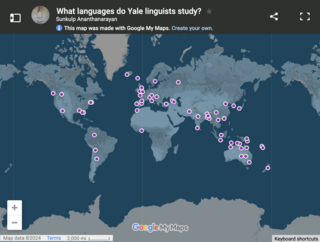The members of our department work on a variety of languages around the world. In some cases a person may have published just one paper on a language, while in other cases this involves a multi-year commitment to a language community.
The list of languages is always changing, especially as new students enter the department, so that it’s impossible to give a definitive list. The map below represents a snapsnot of the diversity of languages by showing the approximate location of languages that Yale linguistics research included in October 2023.
Languages include: Roro/Waima, Bardi, Kullilli/Bulloo River, Diyari/Dieri, Yan-nhaŋu, Burarra, Yidiny/Yidiñ, Hong Kong Cantonese, Hong Kong Mandarin, Vietnamese, Hungarian, Káínai Blackfoot, Wampanoag, Mandarin Chinese, Italian, Yue Chinese, Hindi, Japanese, Pashto, South Bolivian Quechua, Kupang Malay, Central Javanese, Pontianak Malay, Icelandic, Abkhaz, Swedish, Portuguese, Spanish, North American English, Kriol, Djambarrpuyŋu, Akan, Welsh, O’odham, Choctaw.
